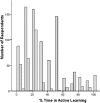Active-learning processes used in US pharmacy education
- PMID: 21769144
- PMCID: PMC3138343
- DOI: 10.5688/ajpe75468
Active-learning processes used in US pharmacy education
Abstract
Objective: To document the type and extent of active-learning techniques used in US colleges and schools of pharmacy as well as factors associated with use of these techniques.
Methods: A survey instrument was developed to assess whether and to what extent active learning was used by faculty members of US colleges and schools of pharmacy. This survey instrument was distributed via the American Association of Colleges of Pharmacy (AACP) mailing list.
Results: Ninety-five percent (114) of all US colleges and schools of pharmacy were represented with at least 1 survey among the 1179 responses received. Eighty-seven percent of respondents used active-learning techniques in their classroom activities. The heavier the teaching workload the more active-learning strategies were used. Other factors correlated with higher use of active-learning strategies included younger faculty member age (inverse relationship), lower faculty member rank (inverse relationship), and departments that focused on practice, clinical and social, behavioral, and/or administrative sciences.
Conclusions: Active learning has been embraced by pharmacy educators and is used to some extent by the majority of US colleges and schools of pharmacy. Future research should focus on how active-learning methods can be used most effectively within pharmacy education, how it can gain even broader acceptance throughout the academy, and how the effect of active learning on programmatic outcomes can be better documented.
Keywords: active learning; pharmacy education; survey; teaching.
Figures
References
-
- Oblinger D Boomers. gen-Xers and millenials: understanding the new students. EDUCAUSE Rev. 2003;38(4):37–47.
-
- Cisneros R, Salisbury-Glennon J, Anderson-Harper H. Status of problem-based learning research in pharmacy education: a call for future research. Am J Pharm Educ. 2002;66(1):19–26.
Publication types
MeSH terms
LinkOut - more resources
Full Text Sources


